A Christmas Carol - "Silent Knight"(-ley)
Sunday, December 14, 2025
 The actress Keira Knightley has several connections to the Festive Season through her films. The actress Keira Knightley has several connections to the Festive Season through her films.
Probably the most celebrated is the ensemble piece "Love Actually" (2003), which pops up on our screens at Christmas every year.
With a cast of illustrious actors, including Rowan Atkinson, Colin Firth, Gregor Fisher, Hugh Grant, Laura Linney, Heike Makatsch, Martine McCutcheon, Liam Neeson, Bill Nighy, Alan Rickman and Emma Thompson, Knightley more than holds her own as the beautiful object of photographer Andrew Lincoln's love.
[Britannica]
Directed by Richard Curtis the film made millions at the Box Office.
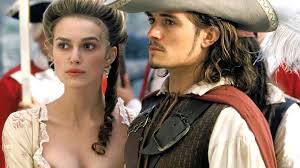 Knightley's first film proper was "Bend it like Beckham" in 2002, when she was just 17 years old. Knightley's first film proper was "Bend it like Beckham" in 2002, when she was just 17 years old.
This brought her much attention and the following year she appeared in "Pirates of the Caribbean: The Curse of the Black Pearl" and "Love Actually", mentioned above. She was still only 18.
Knightley with Orlando Bloom [20 Minutos]
 Other films of note include: "Pride and Prejudice" (2005), in which she played Elizabeth Bennet; "Atonement" (2007), based on the novel by Ian McEwan; and "The Imitation Game" (2014), alongside Benedict Cumberbatch, who played war-time code-breaker Alan Turing. She received an Oscar nomination for Best Supporting Actress for her portrayal of Joan Clarke in this bio-pic. Other films of note include: "Pride and Prejudice" (2005), in which she played Elizabeth Bennet; "Atonement" (2007), based on the novel by Ian McEwan; and "The Imitation Game" (2014), alongside Benedict Cumberbatch, who played war-time code-breaker Alan Turing. She received an Oscar nomination for Best Supporting Actress for her portrayal of Joan Clarke in this bio-pic.
Cumberbatch and Knightley [Spoiler Town]
In between times she has appeared on stage in The West End and on Broadway and has had two daughters (2015 and 2019) with husband James Righton, musician, whom she married in 2013, aged 28.
She was awarded an OBE in 2018.
***
 Her latest appearance is in the current TV Christmas Advert for Waitrose (2025) alongside comedian Joe Wilkinson. In a mini-romantic film comedy lasting four minutes. Her latest appearance is in the current TV Christmas Advert for Waitrose (2025) alongside comedian Joe Wilkinson. In a mini-romantic film comedy lasting four minutes.
She still looks bloody good at the age of 40!
The Perfect Gift | Waitrose | Christmas Ad 2025
[Reason Why]
So, is Keira Knightley just a (very) pretty face, or is she much more?

[Fotogramas]
Links:
The Perfect Gift | Waitrose | Christmas Ad 2025
Love Actually | Cards on the Doorstep - YouTube
DemandGen MAD NOV
© The Culture Vulture
Pictures:
20 Minutos, Britannica, Fotogramas, Reason Why, Spoiler Town,
Acknowledgements:
"Society (Marbella)", The Culture Vulture, Waitrose, Wikipedia
Tags:
20 Minutos, A Christmas Carol, Alan Rickman, Alan Turing, Andrew Lincoln, "Atonement", "Bend it like Beckham", Bill Nighy, Britannica, Broadway, Colin Firth, Dominic Cumberbatch, Emma Thompson, Fotogramas, Heike Makatsch, Hugh Grant, Ian McEwan, James Righton, Joe Wilkinson, Keira Knightley, Laura Linney, Liam Neeson, "Love Actually", Martine McCutcheon, OBE, "Pirates of the Caribbean: The Curse of the Black Pearl", Reason Why, Richard Curtis, "Society (Marbella)", Spoiler Town, The Culture Vulture, "The Imitation Game", Waitrose, West End, Wikipedia
 0
Like
Published at 10:26 PM Comments (0)
0
Like
Published at 10:26 PM Comments (0)
Christmas in Spain
Sunday, December 14, 2025
 The Spanish celebrate Christmas and New Year differently to most other countries. The month-long 'fiesta' lasts from 8th December, Immaculate Conception, through to 6th January, Epiphany. The Spanish celebrate Christmas and New Year differently to most other countries. The month-long 'fiesta' lasts from 8th December, Immaculate Conception, through to 6th January, Epiphany.
What happens in between is different also.
Christmas in Spain [TripSavvy]
Paul Whitelock first wrote about this back in 2020, when the world was still reeling from Covid-19. Many traditional events were cancelled that year.
Paul's alter ego The Culture Vulture has tweaked the original article, which appeared on the Secret Serrania website. Here's the up-to-date version.
Fish for Christmas and no gifts? [2025 version]
By The Culture Vulture

[Photo courtesy of Karl Smallman]
Fish for Christmas dinner? No presents on Christmas Day? Grapes at midnight on New Year’s Eve? What is going on?
The Culture Vulture checks out the Christmas scene in Spain in general and Andalucía in particular.
***
Spain enjoys its Christmas traditions as much as any other Christian countries and cultures, but there are some intriguing differences in the way the Spanish celebrate Navidad.
Just like anywhere else, families gather together to enjoy and celebrate. Whatever the case the goal is to share in the spirit of giving, kindness, and goodwill through food, drink, song, dance, the exchanging of gifts, and other acts of generosity. In Spain, Christmas is normally a festival with fascinating traditions and customs that reflect the true character of the Spanish people.
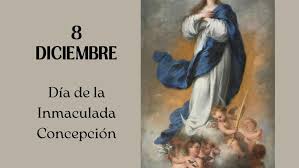 The Christmas period starts as early as December 8th with the Festival of the Immaculate Conception, a national holiday. The Christmas period starts as early as December 8th with the Festival of the Immaculate Conception, a national holiday.
It is celebrated each year in front of the great Gothic cathedral in Sevilla with a ceremony called Los Seises or the “dance of six.” when ten elaborately costumed boys perform a ritual dance.
[Calendarr]
By early December the streets of towns and villages will have been decorated with Christmas lights and the shops will have begun to display their Christmas wares.
 One symbol of Christmas that still maintains great importance throughout Spain is the belén, a Nativity scene or crib. One symbol of Christmas that still maintains great importance throughout Spain is the belén, a Nativity scene or crib.
Often there will be a large municipal belén set up in the main square. And families will queue up to look at it!
Many Spanish homes also have their own belén where in times gone by the family would gather to sing carols.
[Vida Ascendente]
In many small towns, during the nights just before Christmas, the plazas might even have a live Nativity scene, with actors playing the parts of Mary and Joseph and the Three Wise Men, as well as live animals that are often associated with the birth of Christ, like lambs, sheep, and donkeys.
Talking of animals, did you know that the humble cow is an important Christmas symbol here? The Spanish especially honour the cow at Christmas because it is thought that when Mary gave birth to Jesus the cow in the stable breathed on the Baby Jesus to keep Him warm.
 On December 22nd, two important events take place. Schools break up for Christmas and the winning number in the famous Christmas Lottery, el Gordo, is announced. The lottery, one of Europe’s oldest, dates back to 1763, when King Carlos III initiated it. Since then, not one year has passed without it and it is a symbolic moment when Spaniards begin to celebrate the Christmas holidays in earnest. On December 22nd, two important events take place. Schools break up for Christmas and the winning number in the famous Christmas Lottery, el Gordo, is announced. The lottery, one of Europe’s oldest, dates back to 1763, when King Carlos III initiated it. Since then, not one year has passed without it and it is a symbolic moment when Spaniards begin to celebrate the Christmas holidays in earnest.
Last year's winning number [Facebook]
 An interesting tradition, predominantly in the provinces of Granada and Jaén, is that of jumping over bonfires, or hogueras, as a symbolic protection against illness. It is the observance of the winter solstice, the shortest day of the year and the beginning of winter. An interesting tradition, predominantly in the provinces of Granada and Jaén, is that of jumping over bonfires, or hogueras, as a symbolic protection against illness. It is the observance of the winter solstice, the shortest day of the year and the beginning of winter.
Hogueras [Diario JAEN]
Christmas Eve, Nochebuena, is when the Spanish eat their main Christmas meal. Each region has its own distinct specialities.
A common main course, particularly in Andalucía and in coastal areas, is fish, such as hake, trout, sea bream, sea bass or salmon.
In central areas like Castilla León, Castilla la Mancha, and Madrid roast lamb and suckling pig are served.
  
Sea Bream [Vicki Viaja] Roast suckling pig [Visit Southern Spain] Roast Lamb [Kitchen Sanctuary]
For dessert there is quite a spread of delicacies, among them are turrón (nougat) and marzipan, desserts made of honey, egg and almonds that are Arabic in origin, as well as polvorones, a type of sweet bread, and a variety of nuts and dried fruits.
  
turron [Instagram] marzipan [MY SPANISH KITCHEN] polvorones [Amigo foods]
To drink, they opt for cava, the Spanish equivalent of champagne.
***
 After the meal, many Spaniards get their second wind and go to midnight mass, known as La misa del Gallo, or “Cock Mass”. After the meal, many Spaniards get their second wind and go to midnight mass, known as La misa del Gallo, or “Cock Mass”.
This church service is so named because the Cock crowed on Christmas morning to announce the birth of Christ.
[Diocesis de Malaga]
 Christmas day, el Día de Navidad, is more or less a continuation of what began the day before. People spend time with their families, they eat another large meal, and in many families, children enjoy the gifts that they have received from Papa Noel, the Spanish version of Santa Claus. However, the main exchange of gifts does not take place until the Día de Reyes, Three King’s Day, on January 6th. Christmas day, el Día de Navidad, is more or less a continuation of what began the day before. People spend time with their families, they eat another large meal, and in many families, children enjoy the gifts that they have received from Papa Noel, the Spanish version of Santa Claus. However, the main exchange of gifts does not take place until the Día de Reyes, Three King’s Day, on January 6th.
[Spain Explained]
 December 28th marks a day of celebration exclusively Spanish called el Día de los Inocentes, the Day of the Innocents. It represents the anniversary of the murder of babies committed by Herod in Judea. However, this day is far from sombre. Roughly equivalent to our April Fools Day it is a day for practical jokes and laughter. December 28th marks a day of celebration exclusively Spanish called el Día de los Inocentes, the Day of the Innocents. It represents the anniversary of the murder of babies committed by Herod in Judea. However, this day is far from sombre. Roughly equivalent to our April Fools Day it is a day for practical jokes and laughter.
[Urgente24]
 December 31st, New Year’s Eve, Nochevieja, is celebrated, as are so many other things in Spain, out on the streets and in the local squares. December 31st, New Year’s Eve, Nochevieja, is celebrated, as are so many other things in Spain, out on the streets and in the local squares.
People turn up with a bagful of grapes and as the town clock is striking midnight, everybody attempts to eat 12 grapes. According to tradition, those who succeed will have 12 months of good luck and prosperity.
[Diario Femenino]
Families and friends stay together for this celebration which marks the end of one year and the beginning of a new one, and in the case of most Spaniards this means a lively celebration will be had until the early hours of the morning, with fireworks and much drinking.
While most of the Christian world has already begun packing up the Christmas decorations, throwing out the tree, and finding a place for all the gifts, Spaniards are continuing the celebration.
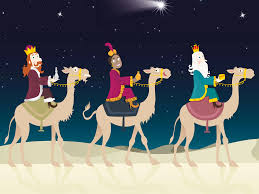 January 6th, el Día de Reyes, Three King’s Day or Epiphany, is the long-awaited day on which the three Kings bring their gifts. January 6th, el Día de Reyes, Three King’s Day or Epiphany, is the long-awaited day on which the three Kings bring their gifts.
On January 5th, children leave their shoes out in a visible spot in the house or on their balcony, and go to bed hoping that when they wake up they will find gifts left by Melchior, Gaspar, and Balthasar.
[Calendarr]
Shoes are filled with straw or barley for the tired camels that must carry their royal riders through the busy night. By morning the camel food is gone and in place of the straw or barley are presents.
 For breakfast or after lunch, families often have the typical dessert of the day, el Roscón de los Reyes, a large ring-shaped cake that is decorated with candied fruits, symbolic of the emeralds and rubies that adorned the robes of the three kings. Somewhere inside the cake there is a surprise, and the person to find it will be crowned King or Queen of the house for the remainder of the day. For breakfast or after lunch, families often have the typical dessert of the day, el Roscón de los Reyes, a large ring-shaped cake that is decorated with candied fruits, symbolic of the emeralds and rubies that adorned the robes of the three kings. Somewhere inside the cake there is a surprise, and the person to find it will be crowned King or Queen of the house for the remainder of the day.
El Roscón de los Reyes [La Vanguardia]
Most big towns and cities have parade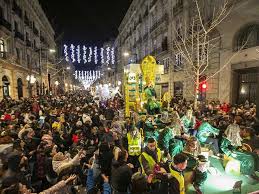 s with each King having a big float that is shaped like a camel. Sometimes there are also real camels in the parade too. s with each King having a big float that is shaped like a camel. Sometimes there are also real camels in the parade too.
So, the Christmas period in Spain lasts for a good month and however strange or different some of the Christmas customs in Spain seem to us guiris, one thing is for sure, everybody has a good time!
[Visit Andalucia]
As the Spanish would say, in the various languages of their country:
¡Feliz Navidad! ¡Bon Nadal! ¡Bo Nadal! ¡Eguberri on!
Links:
British stuff here in Spain? Who needs it? - Eye on Spain
Fish for Christmas and no gifts? - Secret Serrania de Ronda
What is a guiri? It's what the Spanish call us foreigners - but is it good or bad? - Secret Serrania
© The Culture Vulture
Pictures:
Amigo foods, Calendarr, Diario Femenino, Diario JAEN, Diocesis de Malaga, Facebook, Karl Smallman, Kitchen Sanctuary, La Razon, La Vanguardia, MY SPANISH KITCHEN, Spain Explained, TripSavvy, Urgente24, Vicki Viaja, Vida Ascendent, Visit Andalucia, Visit Southern Spain
Acknowledgements:
Eye on Spain, Paul Whitelock, Secret Serrania, Wikipedia
Tags:
12 uvas, 6th January, 8th December, Amigo foods, Año Nuevo, Calendarr, cava, Christmas in Spain, Dia de Los Inocentes, Dia de Navidad, Dia de Reyes, Diario Femenino, Diario JAEN, Diocesis de Malaga, El Gordo, Epifania, Epiphany, Eye on Spain, Facebook, Inmaculada Concepcion, Instagram, Karl Smallman, Kitchen Sanctuary, La Razon, La Vanguardia, Los seises, marzipan, Misa del Gallo, MY SPANISH KITCHEN, Navidad, New Year's Eve, Nochevieja, ONCE, Paul Whitelock, polvorones, Roast Lamb, Roast suckling pig, Secret Serrania, Sea Bream, Spain Explained, The Culture Vulture, TripSavvy, turron, Urgente24, Vicki Viaja, Vida Ascendent, Visit Andalucia, Visit Southern Spain, Wikipedia
 0
Like
Published at 9:01 AM Comments (0)
0
Like
Published at 9:01 AM Comments (0)
John Lennon - dead for 45 years!
Monday, December 8, 2025
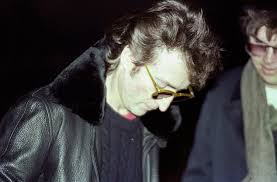 Former Beatle John Lennon was murdered 45 years ago today, on November 8th, 1980. The world was shocked! It happened in broad daylight outside the apartment block in New York where Lennon lived with his second wife, the Japanese multimedia artist Yoko Ono. Former Beatle John Lennon was murdered 45 years ago today, on November 8th, 1980. The world was shocked! It happened in broad daylight outside the apartment block in New York where Lennon lived with his second wife, the Japanese multimedia artist Yoko Ono.
Last known photo of Lennon in 1980 [Daily Mail]
The perpetrator was Mark Chapman, allegedly a huge fan of the singer, composer, guitarist, pianist, actor, poet, who had moved to the USA in 1971 following his rancorous departure from The Beatles a year earlier.
Lennon formed "The Plastic Ono Band", which made just one eponymous album. I bought it, but soon sold it to a friend. I couldn't stand Yoko's wailing and shrieking.
He made solo music too. "Imagine" is a classic and "Double Fantasy", his second-best-selling non-Beatles album, won the 1981 Grammy Award for Album of the Year, and in 1982 the Brit Award for Outstanding Contribution to Music.
 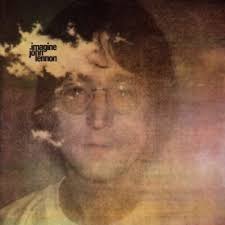 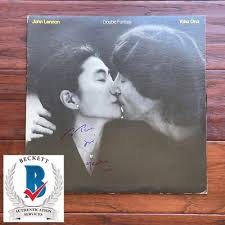
[Toppermost] [eBay UK] [eBay UK]
Posthumously Lennon was voted eighth in a BBC history poll of the 100 Greatest Britons.
Rolling Stone magazine ranked him the fifth-greatest singer and 38th-greatest artist of all time.
He was inducted into the Songwriters Hall of Fame (in 1997) and the Rock and Roll Hall of Fame (twice, as a member of the Beatles in 1988 and as a solo artist in 1994).
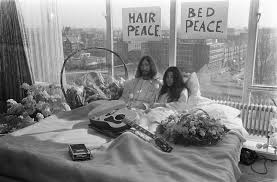 He famously married Yoko in Gibraltar in 1969, just down the road from where I live in Andalucia. He famously married Yoko in Gibraltar in 1969, just down the road from where I live in Andalucia.
Their "Bed-in" in their honeymoon hotel on the Rock was a Peace Protest.
The Press were invited to their suite where the couple were nearly naked in bed.
[Wikipedia]
A complex man
Lennon had issues. He disappeared from Yoko and from the music scene for two years in the mid-70s, during which time he had several affairs.
He and Paul McCartney, the prolific composing duo at the heart of the phenomenal success of the Liverpool band, didn't speak for years.
Lennon took to trying to belittle McCartney through his song lyrics, but Paul and his American wife Linda Eastman (1941 - 1998) ploughed their own furrow, literally when they moved to Mull, a small island in Scotland, where they took up farming.
 McCartney's new band "Wings" were hugely successful, after a quiet start. McCartney's new band "Wings" were hugely successful, after a quiet start.
With former "Moody Blues" singer Denny Laine (d. 2023), and Linda on keyboards and harmony vocals, they scored an immense hit with their third studio album "Band on the Run" (1973).
Linda and Paul [Wikpedia]
It was McCartney's fifth album after leaving The Beatles in April 1970 and his final album on the Apple Records label. Although sales were modest initially, its commercial performance was aided by two hit singles – "Jet" and "Band on the Run" – such that it became the top-selling studio album of 1974 in the United Kingdom and Australia, in addition to revitalising McCartney's critical standing. It remains McCartney's most successful album and the most celebrated of his post-Beatles works.
Back to Lennon
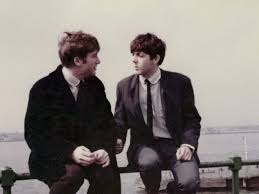 John Winston Ono Lennon (born John Winston Lennon; 9 October 1940 – 8 December 1980) was an English musician and activist. John Winston Ono Lennon (born John Winston Lennon; 9 October 1940 – 8 December 1980) was an English musician and activist.
He gained global fame as the founder, co-lead vocalist and rhythm guitarist of The Beatles.
Lennon's songwriting partnership with Paul McCartney remains the most successful in history.
[The Guardian]
Born in Liverpool, Lennon became involved in the skiffle craze as a teenager. In 1956, he formed The Quarrymen, which evolved into The Beatles in 1960. He initially was the group's de facto leader, a role he gradually seemed to cede to McCartney, writing and co-writing songs with increasing innovation, including "Strawberry Fields Forever", which he later cited as his finest work with the band.
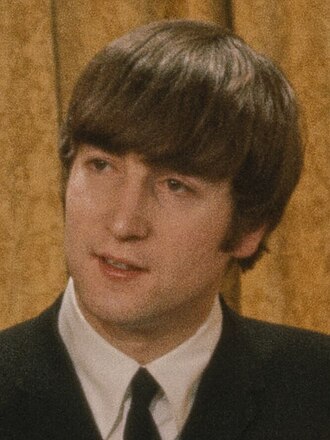  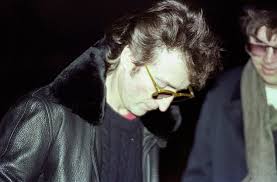
Ed Sullivan Show [1974] [1994] Last known photo [Daily Mail]
Lennon soon expanded his work into other media by acting in numerous films, including "How I Won the War" (1967), and authoring "In His Own Write" (1964) and "A Spaniard in the Works" (1965), both collections of nonsense writings and line drawings.
Starting with "All You Need Is Love", his songs were adopted as anthems by the anti-war movement and the counter-culture of the 1960s.
In 1969, he started the Plastic Ono Band with Yoko Ono, held the "Bed-in" for peace, and left The Beatles to embark on a solo career.
Lennon and Ono collaborated on many works, including a trilogy of avant-garde albums and several more films. After the Beatles disbanded, Lennon released his solo debut "John Lennon/Plastic Ono Band" and the international top-10 singles "Give Peace a Chance", "Instant Karma!", "Imagine", and "Happy Xmas (War Is Over)".
Moving to New York City in 1971, his criticism of the Vietnam War resulted in a three-year deportation attempt by the Nixon administration.
During their separation from 1973 to 1975, Lennon produced Harry Nilsson's album "Pussy Cats". He also had chart-topping collaborations with Elton John ("Whatever Gets You thru the Night") and David Bowie ("Fame").
Following a five-year hiatus, Lennon returned to music in 1980 with the Ono collaboration "Double Fantasy". He was shot and killed three weeks after the album's release.
Aftermath
In line with Yoko Ono's wishes, on 14 December, millions of people around the world paused for 10 minutes of silence to remember Lennon, including 30,000 people gathered in Lennon's birthplace Liverpool and over 225,000 people in Central Park, near the scene of the shooting. During this period, all radio stations in New York City ceased broadcasting.
Chapman was charged with the second-degree murder of Lennon, as premeditation in New York State was not sufficient to warrant a charge of first-degree murder. Despite advice by his lawyers to plead insanity, Chapman pleaded guilty to the murder, saying that it was the "will of God".
Under the terms of his plea, Chapman was sentenced to 20-years-to-life with eligibility for parole in 2000.
Before his sentencing, Chapman was given the opportunity to address the court, at which point he read a passage from "The Catcher in the Rye" by J D Salinger.
As of September 2025, Chapman has been denied parole 14 times and remains incarcerated.
Links:
All You Need Is Love - The Beatles (1967)
Imagine - John Lennon & The Plastic Ono Band (w The Flux Fiddlers) (Ultimate Mix 2018) - 4K REMASTER
Paul McCartney & Wings - Band On The Run (Official Music Video)
Plastic Ono Band - Give Peace A Chance (1969)
THE BEATLES : Rooftop Concert : "Get back" "Don't Let Me Down" "Dig a Pony" - YouTube - last ever live performance
The Beatles - Strawberry Fields Forever
© The Culture Vulture (Paul Whitelock)
Pictures:
Daily Mail, eBay UK, The Guardian, Toppermost, Wikipedia
Thanks:
Apple Corps, Bing, Brian Epstein, EMI, Northern Songs, Parlophone, Paul Whitelock, Wikipedia, YouTube
Tags:
10 minutes of silence, 20-years-to-life, 30,000 people gathered in Lennon's birthplace Liverpool, 45 years ago, Abbey Road, Apple, Apple Corps, Bing, Brian Epstein, Central Park, Chapman pleaded guilty, Daily Mail, David Bowie, denied parole 14 times, Denny Laine, eBay UK, EMI, Elton John, first-degree murder, Harry Nilsson, J D Salinger, John Lennon, Linda Eastman, Liverpool, Mark Chapman, Moody Blues, New York, Northern Songs, November 8th 1980, Parlophone, parole in 2000, Paul McCartney, Paul Whitelock, plead insanity, radio stations in New York City ceased broadcasting, second-degree murder, "The Catcher in the Rye", The Culture Vulture, The Guardian, The Quarrymen, Toppermost, "will of God", Wikipedia, Wings, Yoko Ono, YouTube
 0
Like
Published at 4:06 PM Comments (3)
0
Like
Published at 4:06 PM Comments (3)
Halloween!
Friday, October 31, 2025

Halloween 2025 will be celebrated tonight, Friday, October 31st, marking a festive weekend of celebrations and activities.
Halloween is celebrated annually on October 31st, and this year, 2025, it falls on a Friday, tonight.
[Halloween image courtesy of Freepik]
This timing creates an extended weekend, making it an ideal occasion for parties, trick-or-treating, and various community events.
Origins
 Halloween, also known as All Hallows' Eve, has its roots in the ancient Celtic festival of Samhain, which marked the end of the harvest season and the beginning of winter. Halloween, also known as All Hallows' Eve, has its roots in the ancient Celtic festival of Samhain, which marked the end of the harvest season and the beginning of winter.
It was believed that on this night the boundary between the living and the dead was blurred, allowing spirits to return o Earth.
[CEAN Idiomas]
Celebrations and Activities
 Many communities planned special events throughout October, including costume parties, haunted houses, and trick-or-treating activities. Many communities planned special events throughout October, including costume parties, haunted houses, and trick-or-treating activities.
[BBC]
Historical Context
The origins of Halloween can be traced back over 2,000 years to the Celtic festival of Samjain, when people would light bonfires and wear costumes to ward off wanderinmg spirits.
As Christianity spread the Church sought to replace pagan festivals with Christian holidays, leading to the establishment of All Saints' Day on November 1st.
The night before became known as All Hallows' Eve, eventually shortened to Halloween.
© The Culture Vulture (Paul Whitelock)
Pictures:
BBC, CEAN Idiomas, Freepik,
Tags:
All Hallows' Eve, BBC, CEAN Idiomas, Culture Vulture, Freepik, Halloween, Paul Whitelock, Samhain, trick-or-treat,
 0
Like
Published at 9:32 PM Comments (0)
0
Like
Published at 9:32 PM Comments (0)
87,88,89 and 91 - Too young to die?
Tuesday, October 7, 2025
There has been a spate of deaths recently. All elderly and famous people, and, amazingly, all beautiful - even the men.
87 year-olds
Two of the most beautiful film actors ever have left us in the past month.
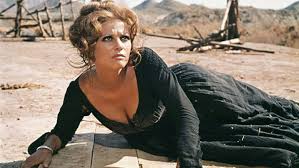 Claudia Cardinale, surely the most beautiful of the Italian actresses who were high profile in the 20th century. Sophia Loren was stunning and Gina Lollobrigida too, but Claudia was the one for me. Claudia Cardinale, surely the most beautiful of the Italian actresses who were high profile in the 20th century. Sophia Loren was stunning and Gina Lollobrigida too, but Claudia was the one for me.
However, as with many beautiful women, she did not age well. Look at Brigitte Bardot and Kathleen Turner.
Claudia Cardinale [CNN]
Star of films which include "81/2", "The Leopard", and "Once Upon a Time in the West", she graced our screens for several decades.
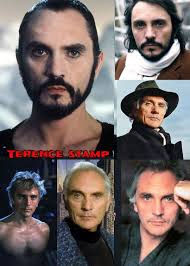 Terence Stamp, widely regarded as the most beautiful man to appear on film. Terence Stamp, widely regarded as the most beautiful man to appear on film.
He made some 60 films, including Star Trek and Star Wars, but he was best known for roles as "The Collector" and the love interest opposite Julie Christie in "Far From the Madding Crowd".
Unlike many beautiful women, Terence Stamp did not lose his looks as he got older.
Terence Stamp [Instagram]
88 is no great age
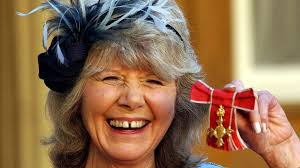 Jilly Cooper, who died suddenly yesterday, was a pioneer of the "bonkbuster". Jilly Cooper, who died suddenly yesterday, was a pioneer of the "bonkbuster".
She made a whole generation of teenagers keen to read again, albeit clandestinely.
Her tales of sex and intrigue created a whole new literary genre.
Jilly Cooper [Photo: elDiario.es]
89 is too young
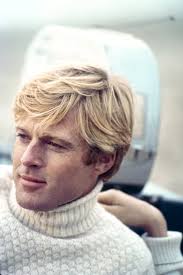 Robert Redford, also regarded as a beautiful man, played a whole range of significant roles. Robert Redford, also regarded as a beautiful man, played a whole range of significant roles.
His films include Barefoot in the Park (1967), Butch Cassidy and the Sundance Kid (1969), The Candidate (1972) and The Sting (1973), with the latter earning him an Academy Award nomination.
His stardom continued with films such as The Way We Were (1973), The Great Gatsby (1974), All the President's Men (1976), and Out of Africa (1985).
Later credits include Sneakers (1992), Indecent Proposal (1993), All Is Lost (2013), Truth (2015), Our Souls at Night (2017) and The Old Man & the Gun (2018).
[El Pais]
Redford made his directorial debut with the family drama Ordinary People (1980), which won four Academy Awards including Best Picture and Best Director. His later directing credits include A River Runs Through It (1992), Quiz Show (1994), and The Horse Whisperer (1998).
A major advocate for independent cinema, Redford co-founded the Sundance Institute and the Sundance Film Festival in 1978.
91 is no great age
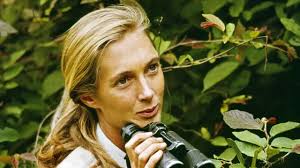 Jane Goodall was a famous English primatologist and anthropologist who studied chimpanzees and gorillas. Jane Goodall was a famous English primatologist and anthropologist who studied chimpanzees and gorillas.
Her sudden death took everybody by surprise.
[BBC]
Described by many publications as "the world's preeminent chimpanzee expert", she was best known for more than six decades of field research on the social and family life of wild chimpanzees in the Kasakela chimpanzee community at Gombe Stream National Park in Tanzania.
Goodall's research demonstrated that chimpanzees share many key traits with humans, such as using tools, having complex emotions, forming lasting social bonds, engaging in organised warfare, and passing on knowledge across generations, which redefined the traditional view that humans are uniquely different from other animals.
In 1965 Goodall was awarded a PhD in ethology from the University of Cambridge. In the 1960s, Goodall published several accounts of her research in Tanzania, including a series of articles in National Geographic.
Goodall established wildlife sanctuaries and reforestation projects in Africa and campaigned for the ethical treatment of animals in animal testing, animal husbandry and captivity.
She was appointed a United Nations Messenger of Peace in 2002, and advised organisations such as Save the Chimps and the Society for the Protection of Underground Networks.
Throughout her career Goodall wrote 32 books, 15 of them for children, and was the subject of over 40 films. She remained an active lecturer, travelling extensively to promote conservation and climate action.
She was an honorary member of the World Future Council. Among other honours, she was a recipient of the National Geographic Society's Hubbard Medal, the Kyoto Prize, the Templeton Prize and the United States Presidential Medal of Freedom.
In 2003 she was named a dame commander of the Order of the British Empire by Queen Elizabeth II.
© The Culture Vulture (aka Paul Whitelock)
Pictures:
BBC, CNN, ElDiario.es, El Pais, Instagram,
Tags:
"81/2", Brigitte Bardot, BBC, CNN, Claudia Cardinale, ElDiario.es, El Pais, "Far From the Madding Crowd", Gina Lollobrigida, Instagram, Jane Goodall, Julie Christie, Kathleen Turner, "Once Upon a Time in the West", Robert Redford, Sophia Loren, "Star Trek", "Star Wars", Terence Stamp, "The Collector", "The Leopard", she graced our screens for several decades.
 0
Like
Published at 9:21 PM Comments (0)
0
Like
Published at 9:21 PM Comments (0)
Batalla de la Puente - Montejaque
Thursday, September 25, 2025
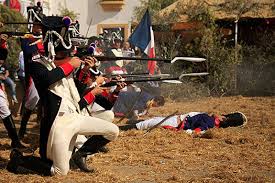 This weekend Montejaque (Malaga) celebrates an important date in its history. Napoleon Bonaparte, emperor of France, had invaded Spain and Portugal in 1807. Britain joined forces with Portugal and Spain to fight against the French, in what the British call the Peninsular War. This weekend Montejaque (Malaga) celebrates an important date in its history. Napoleon Bonaparte, emperor of France, had invaded Spain and Portugal in 1807. Britain joined forces with Portugal and Spain to fight against the French, in what the British call the Peninsular War.
[Diario Ronda]
Arthur Wellesley, later to become The Duke of Wellington, led the British army.
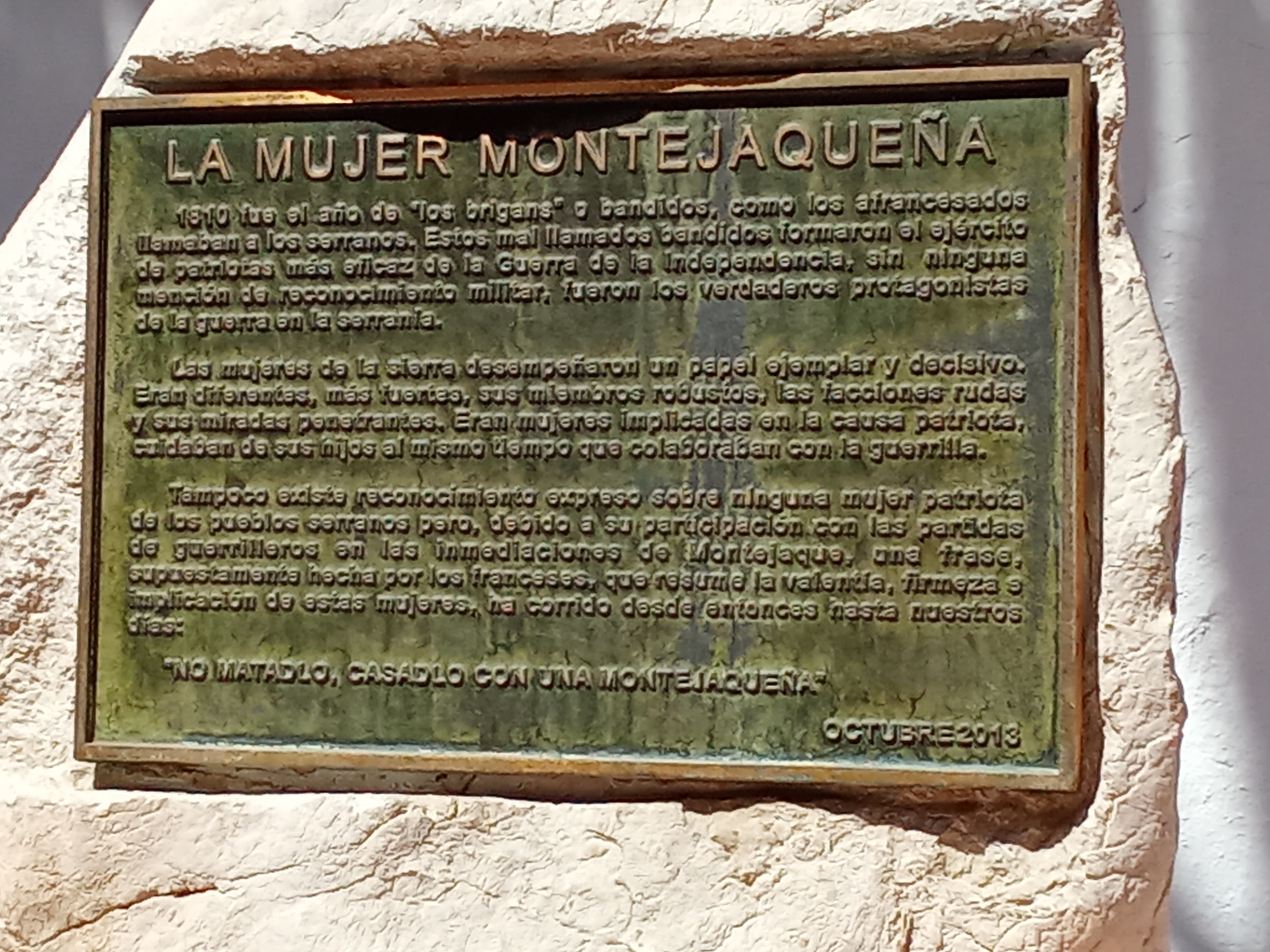 In 1810 a group of 700 French soldiers came upon Montejaque but were repelled by a ragbag of old men, boys and women. In 1810 a group of 700 French soldiers came upon Montejaque but were repelled by a ragbag of old men, boys and women.
The festival called La Batalla de la Puente commemorates this.
It starts tomorrow, Friday September 26 and runs until Sunday.
Plaque commemorating the women of Montejaque [PW]
Preparations
Montejaque (pop. 960) started preparing for the event on Tuesday. The village will be transformed into a 19th century village with straw bales, gardens, a graveyard and rustic stalls.
The mayordomos will erect and run a bar.
The locals will dress up either as French soldiers or as villagers and will re-enact the battle.
There will be activities and music.
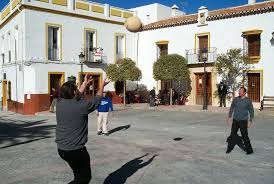 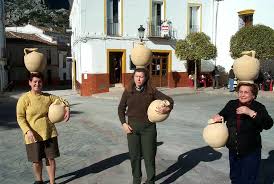
El juego del cantaro [Diputacion Provincial de Malaga]
Background
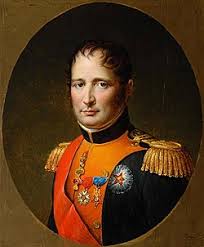 The Peninsular War (1808–1814) was fought in the Iberian Peninsula by Spain, Portugal and the United Kingdom against the invading and occupying forces of Napoleon Bonaparte who had entered Spain and Portugal in 1807 and installed his brother Joseph on the Spanish throne, having forced the abdications of Fernando VII and his father Carlos IV. The Peninsular War (1808–1814) was fought in the Iberian Peninsula by Spain, Portugal and the United Kingdom against the invading and occupying forces of Napoleon Bonaparte who had entered Spain and Portugal in 1807 and installed his brother Joseph on the Spanish throne, having forced the abdications of Fernando VII and his father Carlos IV.
In Spain, it is considered to overlap with the Spanish War of Independence.
Napoleon Bonaparte [Wikipedia]
In 1808, the Spanish army in Andalusia defeated the French at the Battle of Bailen, considered the first open-field defeat of the Napoleonic army on a European battlefield.
Besieged by 70,000 French troops, a reconstituted national government, the Cortes - in effect a government in exile - fortified itself in the secure port of Cadiz in 1810.
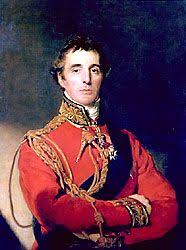 The British army, under Arthur Wellesley, the future Duke of Wellington, guarded Portugal and campaigned against the French alongside the reformed Portuguese Army and provided whatever supplies they could get to the Spanish, while the Spanish Armies and guerrillas tied down vast numbers of Napoleon's troops. The British army, under Arthur Wellesley, the future Duke of Wellington, guarded Portugal and campaigned against the French alongside the reformed Portuguese Army and provided whatever supplies they could get to the Spanish, while the Spanish Armies and guerrillas tied down vast numbers of Napoleon's troops.
In 1812, when Napoleon set out with a massive army on what proved to be a disastrous French invasion of Russia, a combined allied army defeated the French at Salamanca and took the capital Madrid.
Duke of Wellington [Britannica]
In the following year the Coalition scored a victory over King Joseph Bonaparte's army at the Battle of Vitoria paving the way for victory in the war in the Iberian Peninsula.
Highly recommended
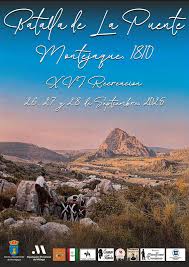 This feria is arguably the best of the many which take place in Montejaque in August and September. This feria is arguably the best of the many which take place in Montejaque in August and September.
I shall be there for the start tomorrow and probably again on Sunday for the closing moments.
I love it!
See you there?
[Poster by Portal Tematico de la Serrania]
Link:
Napoleon Defeated in Montejaque
© The Culture Vulture
Photos:
Britannica, Diario Ronda, Diario Sur, Paul Whitelock, Portal Tematico de la Serrania, Wikipedia
Tags:
Arthur Wellesley, Bailen, Batalla de la Puente, Britannica, Cadiz,Carlos IV, Cortes, Diario Ronda, Diario Sur, Duke of Wellington, Fernando VII, Joseph Bonaparte, Madrid, Montejaque, Napoleon Bonaparte, Paul Whitelock, Portal Tematico de la Serrania, Portugal, Russia, Salamanca, Spain, The Culture Vulture, United Kingdom, Wikipedia
 1
Like
Published at 8:51 PM Comments (0)
1
Like
Published at 8:51 PM Comments (0)
Napoleon Defeated in Montejaque
Wednesday, September 17, 2025
La Batalla de La Puente
This final feria of the summer in Montejaque is not to be missed. of the summer in Montejaque is not to be missed.
Spectacular, charming, quaint and exciting are all adjectives that apply to this celebration of the defeat of Napoleon's troops in 1810.
[Diario Ronda]
La Batalla de La Puente - the feria
 This year this emblematic feria takes place over Friday, Saturday and Sunday, 26, 27 and 28 September. This year this emblematic feria takes place over Friday, Saturday and Sunday, 26, 27 and 28 September.
The central area of the village will be transformed into a 19th century village and the villagers will dress up as French soldiers or as peasants.
In the real battle in 1810, 700 French troops were defeated by a ragbag of farmers, old men and the women of the village.
A plaque outside the church commemorates the event.
[Portal Tematico de la Serrania]
Programme
Not yet available! Why are they always so last minute?
Accommodation
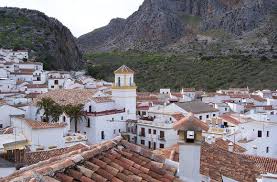 The village fills up for this important fiesta in the cultural life of Montejaque. Relatives of montejaqueños return to the village, as well as curious tourists from many countries, who like to join in the fun.. The village fills up for this important fiesta in the cultural life of Montejaque. Relatives of montejaqueños return to the village, as well as curious tourists from many countries, who like to join in the fun..
The four "hotels" are always full, as are the many casas rurales.
Booking.com, AirBnb, and VRBO have long-since booked up for the three-day event. Some who rent privately or by word of mouth may have availability.
Montejaque from the mirador [Paul Whitelock]
The property listed below has just become available following a late cancellation. Book direct with the owner.
CASA REAL, MONTEJAQUE
 Casa Real has undergone a full renovation, yet has retained many original features. Casa Real has undergone a full renovation, yet has retained many original features.
Now boasting three double bedrooms plus space for a baby, infant or child, Casa Real has become one of the largest rental houses in the village.
With its large L-shaped lounge, dining room and kitchen; shady internal patio; two modern bathrooms; laundry room; and huge roof terrace, Casa Real cannot be further enhanced.
And, what’s more, Casa Real is situated just one minute’s walk from the village square. Access with a vehicle is good and there is ample free parking nearby.
For complete information, please click the link:
CASA REAL, Montejaque (Malaga) - Help me, Ronda
Contact:
Paul Whitelock on (+ 34) 636 52 75 16 We speak English, French, German and Spanish
© The Culture Vulture
Photos:
Diario Ronda, Paul Whitelock, Portal Tematico de la Serrania
Tags:
1810, accommodation, Batalla de la Puente, Casa Real, casa rural, Diario Ronda, feria, fiesta, French troops, mirador, Montejaque, montejaqueños, Napoleon, Paul Whitelock, Portal Tematico de la Serrania, The Culture Vulture, www.help-me-ronda.com
 3
Like
Published at 8:23 PM Comments (0)
3
Like
Published at 8:23 PM Comments (0)
PBMF 2025 - Saturday August 7, Ronda
Tuesday, August 5, 2025
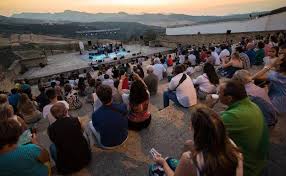 What a setting! The modern open-air concrete "Roman Amphitheatre", perched on Ronda's western cliff edge is a wondrous location. The mountains of the Sierra de Grazalema make a perfect backdrop for any performance. What a setting! The modern open-air concrete "Roman Amphitheatre", perched on Ronda's western cliff edge is a wondrous location. The mountains of the Sierra de Grazalema make a perfect backdrop for any performance.
[Photo: Diario Sur]
We arrived just after 9.00 pm as the first act was beginning its set. "We" were myself and my German friends Iris and Rainer who I've known for some 16 years, since I immigrated to Spain, in fact, to live with my German sweetheart Rita.
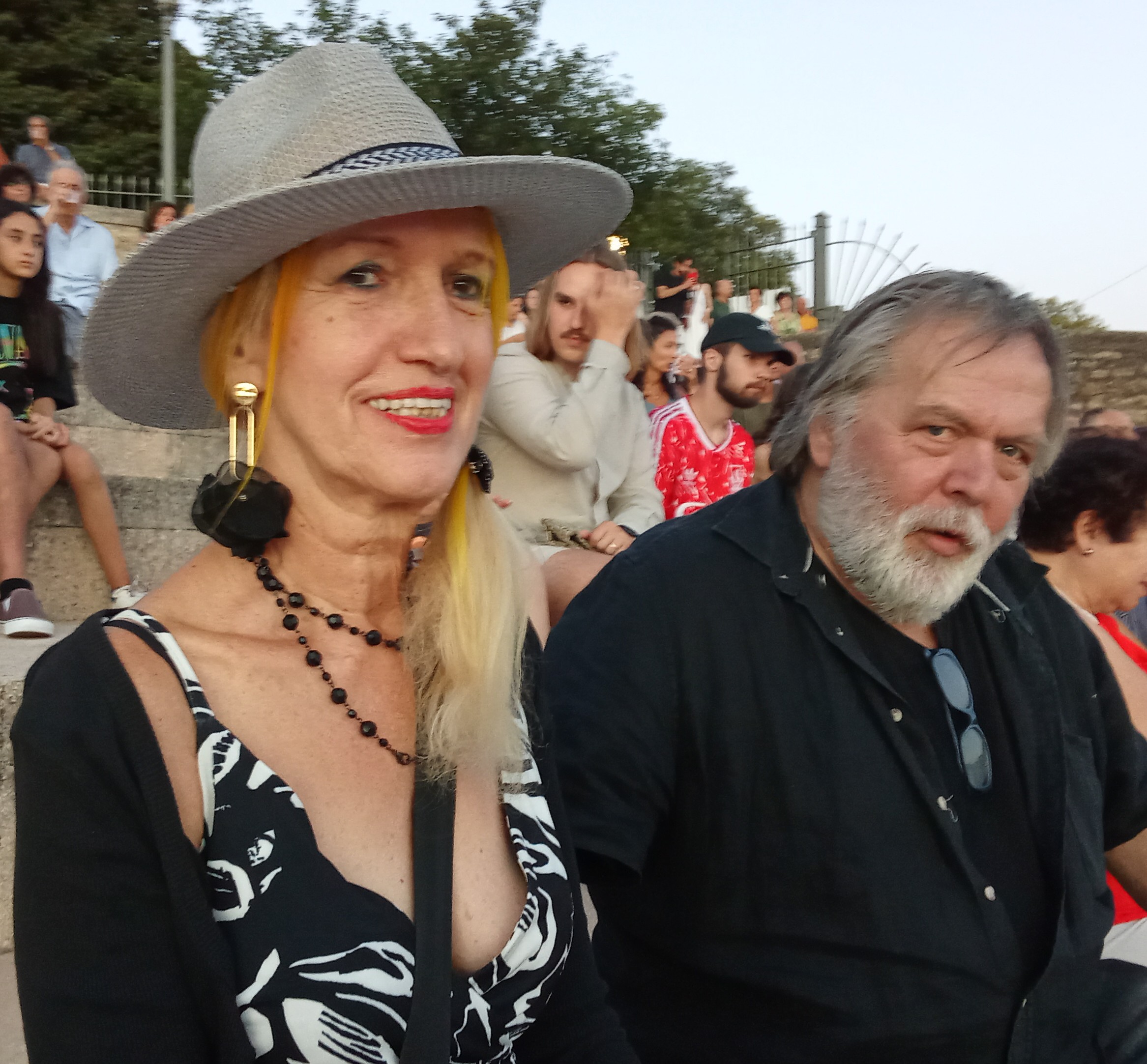 Iris and Rainer owned (and still do) the house next to our home in Montejaque, a village near Ronda. Iris and Rainer owned (and still do) the house next to our home in Montejaque, a village near Ronda.
As it turns out, Montejaque is the base of the PBMF, although not back then.
This festival did not debut until 2016.
Iris and Rainer [Photo: Paul Whitelock]
Robin Mordecai and Diego Castillo-Olivares
Robin is a talented singer-songwriter and multi-instrumentalist from Austin, Texas.
Robin reminded the audience, small at this early hour (the Spanish go out late!), that this was his fourth consecutive time at the festival and that four years ago was when he first met Diego from England, then a 13-year-old, born to Spanish parents who had emigrated to England.
2020 was also the first time I attended the festival and I got to know them both.
Diego made a guest appearance on drums in a jam session which also featured Robin on guitar, as well as other players from the USA and Europe. Diego was just 13-years-old at the time!
Back to the present, Diego is poised to go to Bristol University in October to study Design/Mechanical Engineering, exactly what my brother Simon did there, albeit over 50 years previously.
Back to the concert and Robin was singing and playing electric guitar, backed by Diego on acoustic Spanish guitar.
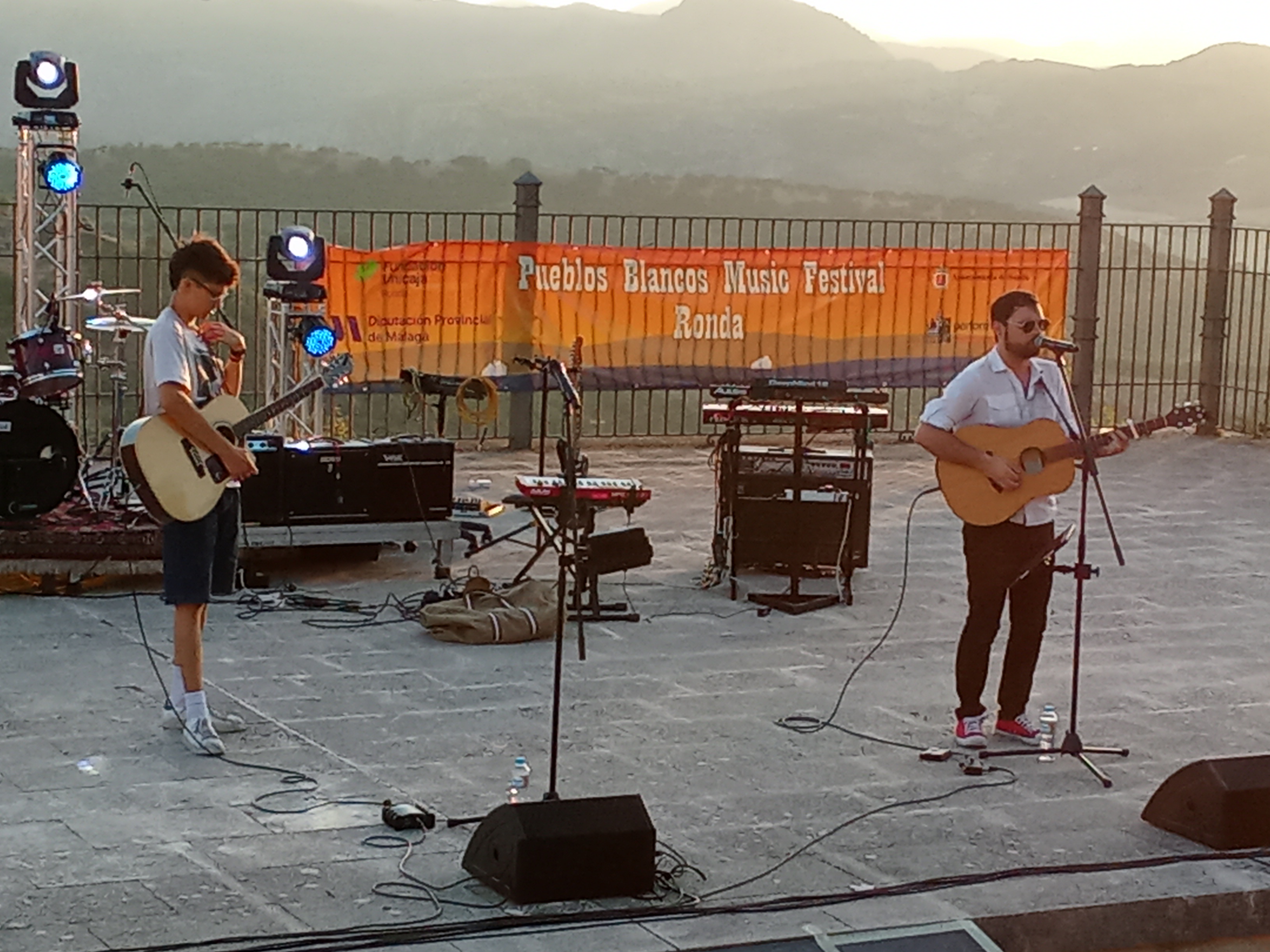
They were fabulous! Robin's powerful voice and Diego's consummate guitar-picking really got the evening off to a a great start.
 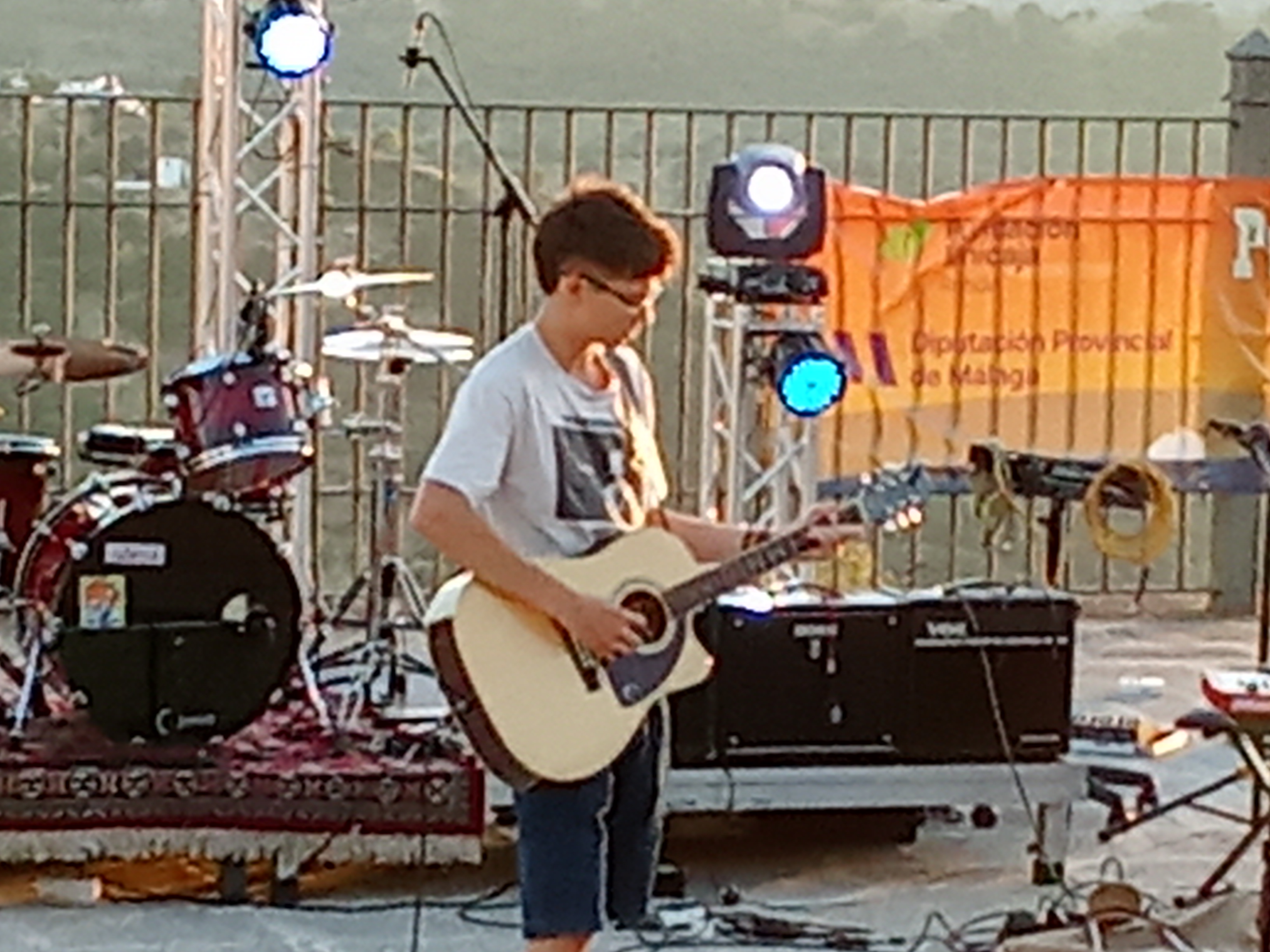
Photos of Robin and Diego on stage in Ronda by Paul Whitelock
Leeann Atherton
Next up were Leeann Atherton and her band from Alabama via California. This band was new to me..
Before us stood an old dear dressed in cowboy gear and clutching a guitar. Towering over her was a rather large younger man. It didn't look promising!
Sitting down was a man with an electric guitar and off to the side a keyboard player. After tuning up, the band burst into song. It was an a cappella harmony. Blimey! West Coast rockabilly at its best.

Photo by Paul Whitelock
Leeann then introduced her band. The big lad beside her at the front of the stage, was her son, Austin!
They then played a rousing set of Country and Western with a tinge of the Blues.
Austin also played mean guitar and mouth organ, as well as possessing a powerful and clear baritone singing voice.
I bumped into Leeann later and we had a great chat. We exchanged contact details, so we'll see how that goes.
Puerto de Santa Maria (Cadiz)
The next two groups were from my favourite place on the Cadiz coast, El Puerto de Santa Maria.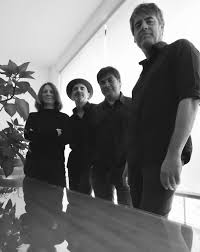
Unfortunately, as far as I and my two companions were concerned, both bands were a great disappointment. The worst was that they occupied the peak slot and the organisers couldn't get them off!
The Maddening Flames, an eight-piece with more guitars than soft Mick (whoever he was!), and just one female voice, outstayed their welcome.
They lived up to their name - they were maddening! - simply samey and boring.
The core members of The Maddening Flames [Facebook]
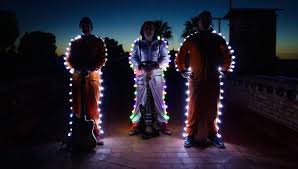 Los Jaguares de la Bahia were nothing more than a joke! A parody. Los Jaguares de la Bahia were nothing more than a joke! A parody.
Three old guys, two on guitar and one on keyboards with lights on their costumes.
The best "musician" was the synthesiser drummer.
[Photo courtesy of Vertigo Estival]
Donovan Keith and friends
 Why they kept this ensemble back to so late is beyond belief. Donovan Keith, from Austin, Texas, is amazing. He has a fabulous tenor voice and is a great ukelele player (on a par with the late great George Formby! - joke, ha-ha). Why they kept this ensemble back to so late is beyond belief. Donovan Keith, from Austin, Texas, is amazing. He has a fabulous tenor voice and is a great ukelele player (on a par with the late great George Formby! - joke, ha-ha).
His collaborators were Robin Mordecai (q.v.) on drums, Diego Castillo-Olivares (q.v.) on guitar and Jason from Canada on bass guitar.
Donovan Keith and friends on stage in Montejaque [PW]
We enjoyed their first few numbers, before it was time to go home and go to bed.
Conclusion
 Look, the Pueblos Blancos Music Festival is all free, so we shouldn't moan. Look, the Pueblos Blancos Music Festival is all free, so we shouldn't moan.
As for me, I love live music, warts and all. It was once again a privilege to experience this amazing event.
[Poster courtesy of Sierra de las Nieves]
Links:
Pueblos Blancos Music Festival 2022 | Cartel, entradas, horarios y hoteles - www.fanmusicfest.com
Pueblos Blancos Music Festival 2025 - Austin & Andalucía Music Festival
Pueblos Blancos Music Festival Mark VIII - Eye on Spain
Pueblos Blancos Music Festival - Ronda Today
© The Culture Vulture
Photos:
Diario Sur, Paul Whitelock, Sierra de las Nieves, Vertigo Estival
Tags:
Austin, Cortes de la Frontera, Culture Vulture, Diario Sur, Diego Castillo-Olivares, Donovan Keith, El Colmenar, Jimera de Libar, Leann Atherton, Montejaque, Mozambique, Olvera, Paul Whitelock, Pueblos Blancos Music Festival, Robin Mordecai, Ronda, Serrania de Ronda, Sierra de Grazalema, Sierra de las Nieves, Teatro Romano, Texas, Vertigo Estival
 3
Like
Published at 10:15 PM Comments (0)
3
Like
Published at 10:15 PM Comments (0)
A Busy Start (and Finish) to August!
Thursday, July 31, 2025
 Yes, August is the month when Spain lets its hair down, celebrating fiesta after feria after dia santo (saint's day). Yes, August is the month when Spain lets its hair down, celebrating fiesta after feria after dia santo (saint's day).
Where do I begin?
There's so much going on in Ronda and the Serrania in the coming days, it would be impossible to go to everything!
[Poster courtesy of Facebook]
Thursday 31 July - Sunday 3 August
Pueblos Blancos Music Festival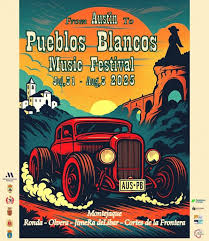
Today marks the start of the Pueblos Blancos Music Festival. The opening night takes place in Montejaque, near Ronda.
Montejaque is the base for the festival which is in its eighth year. The musicians are all accommodated and fed in Montejaque, where there are four days of live music.
[Poster courtesy of Noticias Clave]
Over the next four days the festival also takes in Cortes de la Frontera, Jimera de Libar, Olvera and Ronda.
The musicians, all professional, come predominantly from Austin, Texas, but there are also artistes from France, Guatemala, Mozambique, Norway, Spain, and the UK.
The full programme, giving dates, times and line-ups, is available here:
Pueblos Blancos Music Festival 2025 - Austin & Andalucía Music Festival
31 July - 3 August
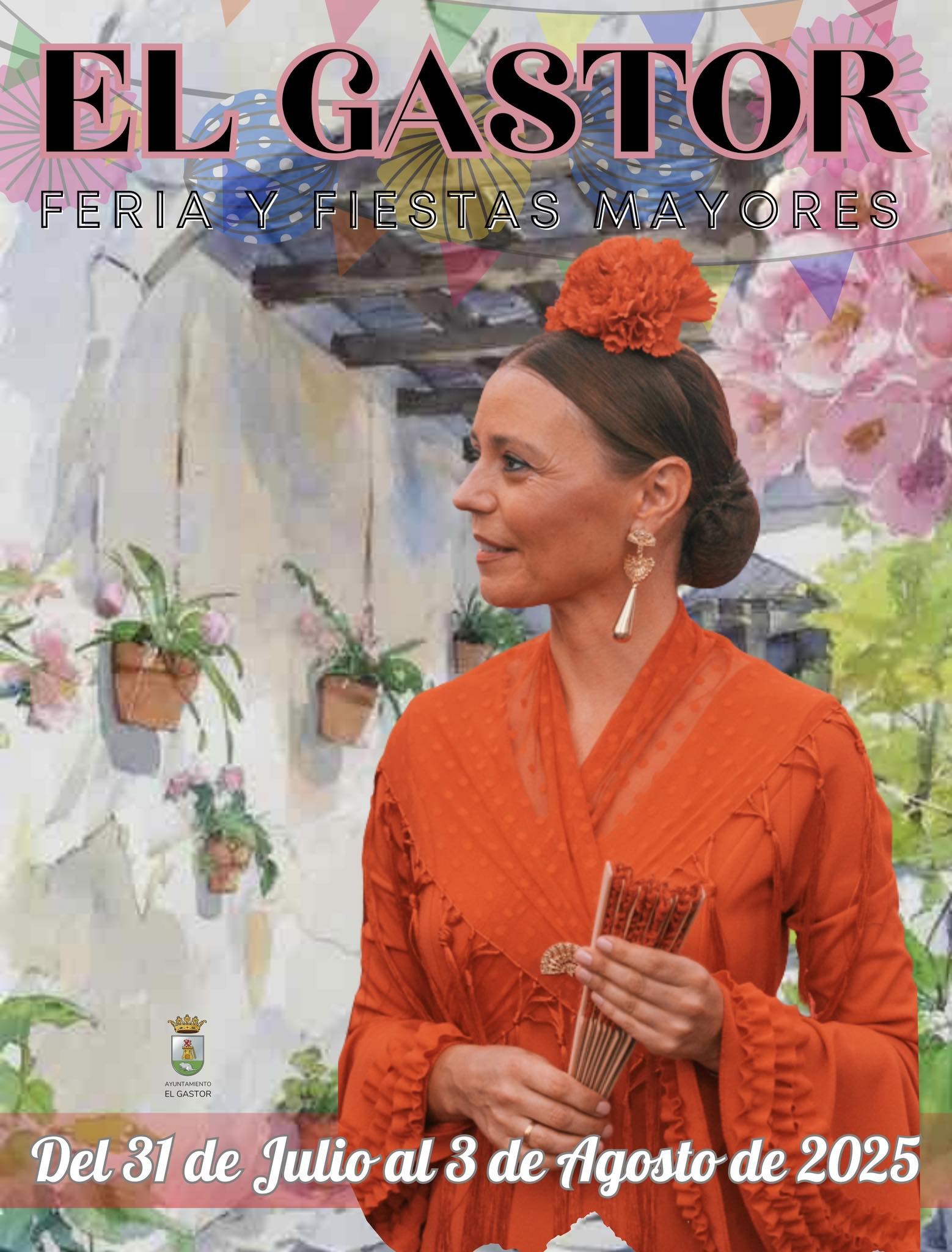 Feria y Fiestas Mayores Feria y Fiestas Mayores
El Gastor (Cadiz)
El primer fin de semana del mes de agosto, El Gastor celebra su Feria y Fiestas Mayores.
Entre los actos que se desarrollan destacan las actuaciones musicales, competiciones deportivas y la tradicional suelta de vaquillas a mediodía y el Toro de fuego a media noche que llenan las calles de El Gastor de visitantes.
Se suele celebrar en la Plaza de la Constitución un bingo popular con muchísima afluencia.
Muchos actos y muy diversos para la que es una de las ferias más concurridas de la sierra gaditana.
[Poster: guiadecadiz.com]
31 July - 23 August
Conciertos de Verano en Ronda

[Portal Tematico Serrania de Ronda]
31 July - 3 August
Feria y Fiestas de Parauta 2025
Fiestas en honor de la Virgen del Rosario
Further information here:
Feria y Fiestas de Parauta 2025 - Portal Temático Serranía de Ronda
Weekends up to 31 August
Exposición de Jennifer Waterhouse
Calle Toledillo 42, Gaucin
Sábados y Domingos de 11:00 a 16:00
Jennifer Waterhouse nació en el norte de Inglaterra y estudió pintura en Leeds College of Art, y después en el Royal College of Art en Londres.
Enseñó pintura en Rochdale College of Art , y luego en Sir John Cass College, y en un instituto para chicos, ambos en Londres.
Ha vivido más de 40 años en España, primero en Madrid y Málaga, y ahora lleva más de 20 años viviendo en Gaucín.
Su pintura está basada más que nada en Gaucín y el campo que lo rodea. Suele pintar en exteriores, aunque también tiene un estudió en Gaucín.
[Poster courtesy of Art Gaucin]
Ha exhibido pinturas en Londres, Málaga, Estepona, Guadiaro y Gibraltar, pero ahora normalmente exhibe con el colectivo de artistas Art Gaucin.
Further information here:
Jennifer Waterhouse - Art Gaucín
Friday 1 August
Casa Museo Don Bosco, Ronda
Flamenco Guitar Concert - Carlos Perez (Cadiz)
For one night only
Tickets - 20 euros - available from Casa Museo Don Bosco, Oficina de Turismo or online at the Chipta ticketing webshop:
SPECIAL CONCERT – FRIDAY 1 AUGUST 2025
Photo of Carlos Perez [Casa Museo Don Bosco]
More information here:
Flamenco Guitar Concerts - Casa Museo Don Bosco
2-9 August
'Semana Cultural' de Pujerra (46a edicion)
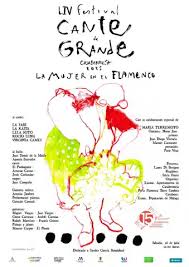
[Fiestas Singulares de Malaga]
3-4 August
'Farajan te cuenta'

[Portal Tematico de la Serrania de Ronda]
Festival de cuentos, musica y poesia
Plaza del Mirador, Farajan (Malaga)
Tuesday 5 August
MARTES CON ARTE en Atajate
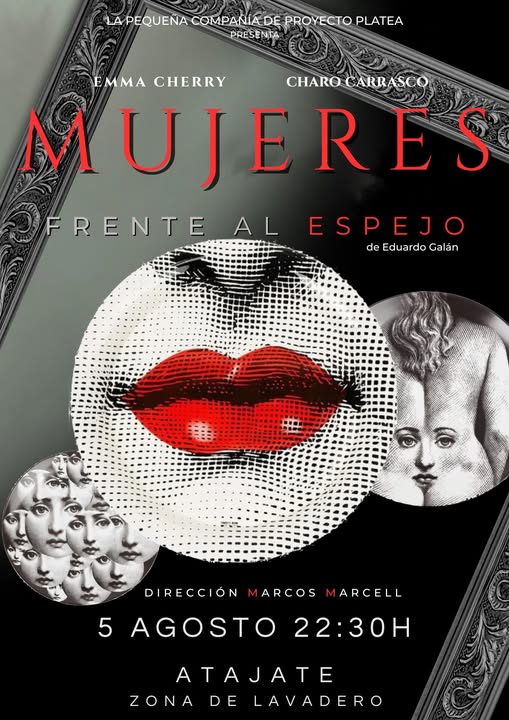 "Mujeres Frente al Espejo" "Mujeres Frente al Espejo"
By Eduardo Galan
Performed by:
Compañia Platea de Ronda
Zona de lavadero municipal, Atajate
Entrada libre
Una propuesta teatral intima y conmovedora que invita a la reflexion sobre la identidad, los vinculos femeninos y los silencios que habitan en el interior de cada persona.
[Poster courtesy of Proyecto Platea]
7 - 10 August
Feria de Agosto
Gaucin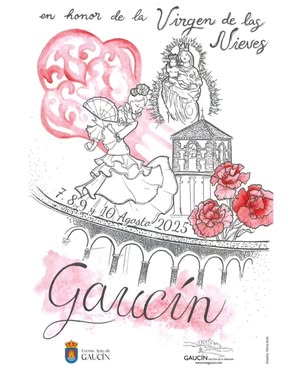
Se celebra en honor de la virgen de las Nieves y en recuerdo de la feria del ganado. Lugareños, visitantes y emigrantes que retornan en estas fechas para reencontrarse con familiares y amigos, celebran las fiestas con bailes, casetas, concursos, dianas, pasacalles, cohetes y competiciones deportivas.
El recinto ferial dispone de Caseta Municipal, con actuaciones musicales, grandes orquestas y programación para todo tipo de público. Asimismo el recinto ferial dispone también de la caseta de la juventud, espacio para que los jovenes den rienda suelta en estos dias festivos. Y como no, atracciones mecánicas para los pequeños.
[Poster by M. Jose Fernandez]
FERIA 2025
The official poster for the 2025 Fair, by M. José Fernández, captures the essence of this special celebration.
The full schedule for these four exciting days will be available very soon.
#feria #gaucin #visitgaucin #balcondelaserrania #virgendelasnieves #agosto #tradicion #verano
9 - 16 August
'Festival Arte Vivo 2025'
Genalguacil (Malaga)
Exposiciones de arte, conciertos, talleres y presentaciones

[Diputacion Provincial de Malaga]
14 August
Vanesa Martin
Recinto Ferial 'Angel Harillo' de Ronda

[Poster: Grupo Mundo]
15 August
'Los Morancos'
Recinto Ferial 'Angel Harillo' de Ronda

[Poster: Grupo Mundo]
23 August
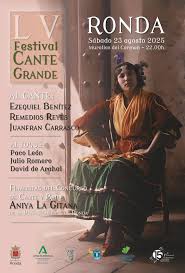 Festival de Cante Grande Festival de Cante Grande
Las Murallas del Carmen, Ronda
22.00 horas
Ezequiel Benitez, Remedios Reyes y Juan-Fran Carrasco al cante;
Paco Leon, Julio Romero y David Arahal al toque.
[Portal Tematico Serrania de Ronda]
El flamenco: Patrimonio Cultural de Andalucía
El flamenco es una de las expresiones culturales más profundas y emotivas de Andalucía. Este arte, que ha sido reconocido como Patrimonio Cultural Inmaterial de la Humanidad por la UNESCO, es una parte integral de la Feria de Ronda. El Festival de Cante Grande es una manifestación de esta rica tradición, ofreciendo a locales y visitantes la oportunidad de disfrutar de actuaciones de altísimo nivel en un entorno histórico incomparable.
29 - 31 August
'Gala Folklorica Internacional de Ronda'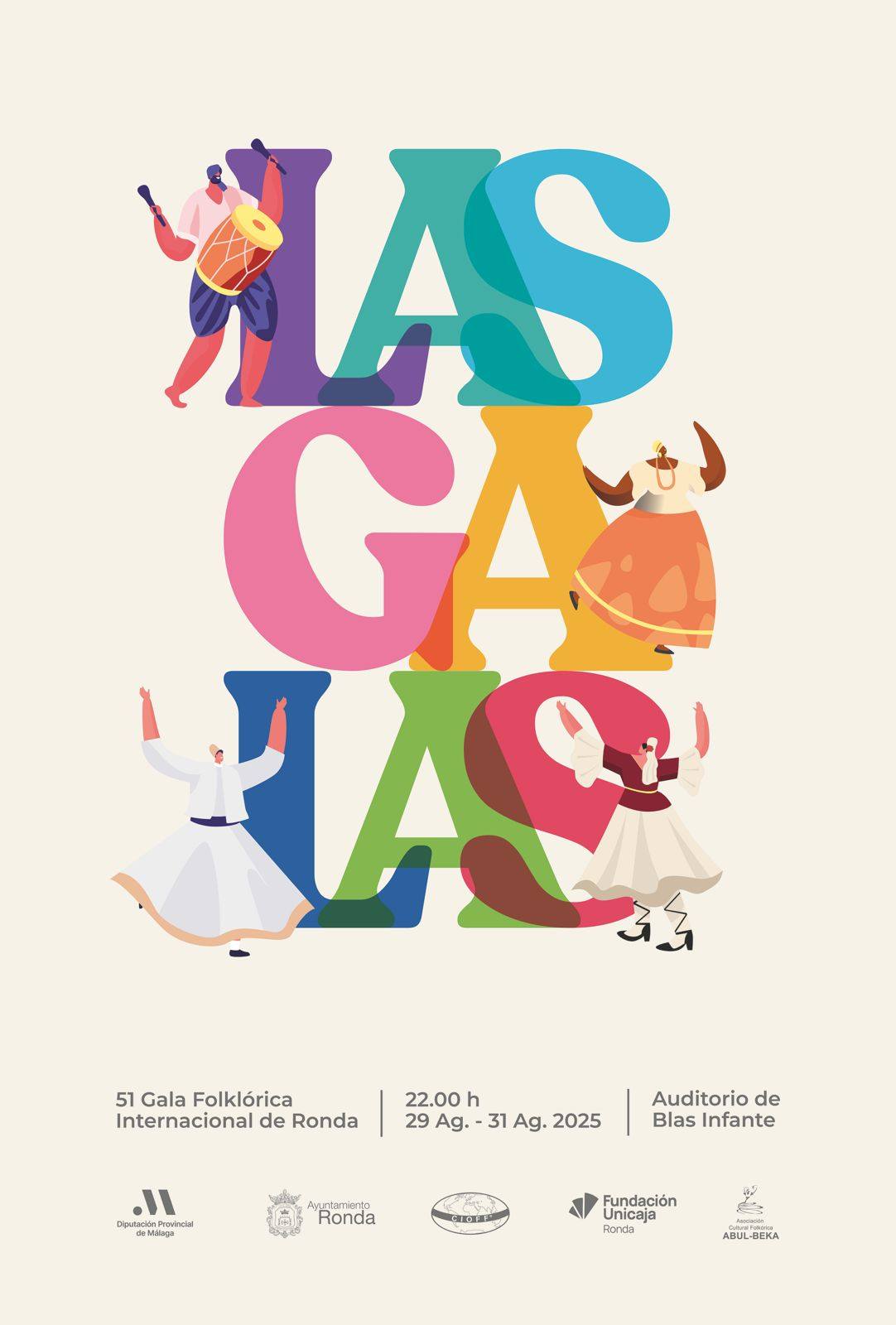
Auditorio de Blas Infante, Ronda
22.00 horas
Evento organizado por Asociacion Cultural Folklorica Abul-Beka con el apoyo del Ayuntamiento de Ronda, de la Diputacion de Malaga, la Fundacion Unicaja y CIOFF.
[Poster sponsored by Ayuntamiento de Ronda]
30 August
20th Anniversary Celebration
Hotel Molino del Puente, Fuente de la Higuera, Ronda
Featuring Marcus Myers 'live'
The Love Family, successful restaurateurs on the coast ('The Harbour Lights', Cabopino), decided to move inland at the turn of the century and bought a dilapidated mill just outside Ronda. After a major renovation project which turned the molino into a bijou boutique hotel and a fine restaurant, they opened their doors on August 30, 2005.
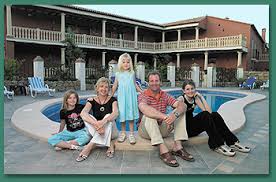
The Love family in 2005 [Karl Smallman]
 Marcus Myers Marcus Myers
Originally trained as a plumber, Marcus was also an accomplished singer/songwriter, which gained him a berth in the backing band for the internationally famous duo Alisha's Attic in the 1990s/early 2000s.
Marcus moved to Spain, to Cortes de la Frontera (Malaga, Andalucia), with his half-Spanish wife, Carmen in 2000. He no longer "plumbs" - he earns his living from music.
Marcus Myers [MMMusic]
Marcus Myers embraces new challenges in a music career that has spanned more than 40 years | Sur in English
As for the 20th Anniversary Celebration, I've already reserved - just for me. My wife Rita will be away in Germany, so, unless I find myself a dinner date, I shall be dining de Rodriguez!
PLEASE NOTE: This article is not yet completed. As further information becomes available, it will be added
© The Culture Vulture
Links:
Feria y Fiestas de Parauta 2025 - Portal Temático Serranía de Ronda
Flamenco Guitar Concerts - Casa Museo Don Bosco
Gaucín - Ayuntamiento de Gaucín
Jennifer Waterhouse - Art Gaucín
Marcus Myers embraces new challenges in a music career that has spanned more than 40 years | Sur in English
Pueblos Blancos Music Festival 2025 - Austin & Andalucía Music Festival
SPECIAL CONCERT – FRIDAY 1 AUGUST 2025
Acknowledgements:
Art Gaucin, Atajate, Ayuntamiento de Atajate, Ayuntamiento de Gaucin, Ayuntamiento de Parauta, Casa Museo Don Bosco, Compañia Platea, Diputacion Provincial de Malaga, Facebook, Grupo Mundo, guiadecadiz.com, Jennifer Waterhouse, Karl Smallman, M. Jose Fernandez, Martes con arte, "Mujeres enfrente al espejo", Noticias Clave, Portal Tematico Serrania de Ronda, Pueblos Blancos Music Festival, SUR in English, Tony Bryant, Virgen de las Nieves
Tags:
Alisha's Attic, Art Gaucin, Atajate, Ayuntamiento de Atajate, Ayuntamiento de Gaucin, Ayuntamiento de Parauta, Cabopino, Carlos Perez, Casa Museo Don Bosco, Compañia Platea, concert, Convento, Cortes de la Frontera, Culture Vulture, Facebook, Festival de Cante Grande, flamenco, Gaucin, guiadecadiz.com, Harbour Lights, Jennifer Waterhouse, Jimera de Libar, Karl Smallman, La Muralla, Marcus Myers, M. Jose Fernandez, Marcus Myers, Martes con arte, "Mujeres enfrente al espejo", Noticias Clave, Olvera, Plaza de Toros, Portal Tematico Serrania de Ronda, Pueblos Blancos Music Festival, Ronda, SUR in English, Tony Bryant, Virgen del Rosario.
 3
Like
Published at 12:47 PM Comments (0)
3
Like
Published at 12:47 PM Comments (0)
Pueblos Blancos Music Festival Mark VIII
Tuesday, July 22, 2025
 Yes, another year has passed and live music on a grand scale returns to the Serrania de Ronda from Thursday July 31 to Sunday August 3, 2025. Yes, another year has passed and live music on a grand scale returns to the Serrania de Ronda from Thursday July 31 to Sunday August 3, 2025.
Some venues were changed in 2024. Montejaque remains the hub, Ronda is still a major venue, but two previous participants, Grazalema and Villaluenga del Rosario, dropped out.
In came Cortes de la Frontera, Jimera de Libar, and Olvera.
[Poster by Noticias CLAVE]
The Pueblos Blancos Music Festival 2025 will feature 25 bands from around the world, including a dozen from Austin, Texas.
 
Donovan Keith from Texas [Facebook] Los Widowmakers from Barcelona [Ruta 66]
The concerts are free to attend.
For details of the acts, more photos, dates, venues and times, check the weblinks below:
Links:
International music festival takes over 'pueblos blancos' in Ronda mountains | Sur in English
Pueblos Blancos Music Fest #5
Pueblos Blancos Music Festival 2025 | Ronda | Andalucia.com
Pueblos Blancos Music Festival - Fairs & Festivals - Visit Costa del Sol - Costa del Sol Málaga
Pueblos Blancos Music Festival - Portal Temático Serranía de Ronda
Pueblos Blancos Music Fest presenta su cartel para su octava edición – Magazine Rock
Ya casi llega la octava edición... - Pueblos Blancos Music Festival | Facebook
© The Culture Vulture
Further Links:
Gallery - Help me, Ronda
Pueblos Blancos Music Fest
Pueblos Blancos Music Festival - Ronda Today
Thanks:
Facebook, Juan de Castro, Karl Smallman, Noticias CLAVE, Paul Whitelock, Ronda Today, Ruta 66
Tags:
Austin, Cortes de la Frontera, Donovan Keith, Facebook, Grazalema, Jimera de Libar, Montejaque, Noticias CLAVE, Olvera, Pueblos Blancos Music Festival, Ronda, Ruta 66, Texas, Villaluenga del Rosario, Widowmakers, www.help-me-ronda.com, www.pueblosblancosmusicfestival.com
 0
Like
Published at 6:27 AM Comments (0)
0
Like
Published at 6:27 AM Comments (0)
Spam post or Abuse? Please let us know
|
|